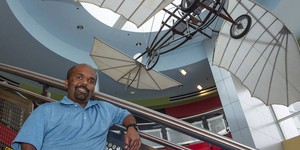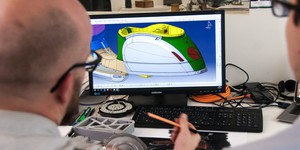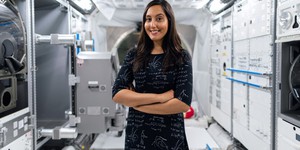What Makes a Good Aerodynamic Design? Test Your Ideas with High-Performance Paper Gliders
390 reviews
Log In
Summary
Areas of Science
Difficulty
Time Required
Average (6-10 days)
Prerequisites
None
Material Availability
Readily available
Cost
Low ($20 - $50)
Safety
No issues
Credits
Ben Finio, PhD, Science Buddies
Andrew Olson, PhD, Science Buddies
*Note:
For this science project you will need to develop your own experimental procedure. Use the information in the summary tab as a starting place. If you would like to discuss your ideas or need help troubleshooting, use the Ask An Expert forum. Our Experts won't do the work for you, but they will make suggestions and offer guidance if you come to them with specific questions.
If you want a Project Idea with full instructions, please pick one without an asterisk (*) at the end of the title.
If you want a Project Idea with full instructions, please pick one without an asterisk (*) at the end of the title.
Abstract
You have probably made plenty of regular paper airplanes simply by folding a piece of printer or notebook paper. Have you ever tried making a "high performance" paper glider? These gliders use a different construction technique that involves cutting multiple shapes out of thicker, stiffer paper and gluing them together (this process is called lamination). There are many resources online that can get you started with the art of making high performance paper gliders. See the references in the Bibliography section or check out a book like Fabulous Paper Gliders. Once you have some experience making the gliders, pick independent and dependent variables and conduct an experiment. For example, you could measure how using different weights of paper or different amounts of glue affects flight distance, or how different glider designs compare to each other. Remember that there will be a lot of variability between individual throws of a paper airplane, so you will need to conduct many trials to get good data.Bibliography
- Ivy, M. (2004, January 16). High-Performance Paper Airplanes: G-1. Zovirl Industries. Retrieved April 10, 2015.
- Glenn Research Center, NASA (2022, July 28). Gliders. Retrieved August 4, 2023.
- AG Industries (2003). Whitewings Science of Flight Lesson Plan. AG Industries. Retrieved April 13, 2015.
Ask an Expert
Do you have specific questions about your science project? Our team of volunteer scientists can help. Our Experts won't do the work for you, but they will make suggestions, offer guidance, and help you troubleshoot.
Global Connections
The United Nations Sustainable Development Goals (UNSDGs) are a blueprint to achieve a better and more sustainable future for all.
This project explores topics key to Industry, Innovation and Infrastructure: Build resilient infrastructure, promote sustainable industrialization and foster innovation.
Careers
If you like this project, you might enjoy exploring these related careers:
Career Profile
Humans have always longed to fly and to make other things fly, both through the air and into outer space—aerospace engineers are the people that make those dreams come true. They design, build, and test vehicles like airplanes, helicopters, balloons, rockets, missiles, satellites, and spacecraft.
Read more
Career Profile
Have you always loved art? Do you have a good eye for beauty, balance, and form? How would you like to see your designs show up in toy stores? Or in a sporting goods store? Or at a car dealer? Commercial and industrial designers create the shape and form of every type of manufactured good that you can think of—from toys, sporting goods, and medical equipment to high technology products, furniture, toothbrushes, and toasters. They design the form of new products that are as beautiful and…
Read more
Career Profile
Aerospace engineering and operations technicians are essential to the development of new aircraft and space vehicles. They build, test, and maintain parts for air and spacecraft, and assemble, test, and maintain the vehicles as well. They are key members of a flight readiness team, preparing space vehicles for launch in clean rooms, and on the launch pad. They also help troubleshoot launch or flight failures by testing suspect parts.
Read more
Related Links
- Science Fair Project Guide
- Other Ideas Like This
- Aerodynamics & Hydrodynamics Project Ideas
- My Favorites
Cite This Page
General citation information is provided here. Be sure to check the formatting, including capitalization, for the method you are using and update your citation, as needed.MLA Style
Finio, Ben, and Andrew Olson.
"What Makes a Good Aerodynamic Design? Test Your Ideas with High-Performance Paper Gliders." Science Buddies,
5 Aug. 2023,
https://www.sciencebuddies.org/science-fair-projects/project-ideas/Aero_p009/aerodynamics-hydrodynamics/what-makes-a-good-aerodynamic-design-paper-gliders?class=AQUDbLP4e80SwuXHSrpz5Yqx-1uLW9ungbIZMakpHT1P41dfX5v342dPGFmcybuUNwYUrbTq6OoVyQc5kXZi4DSX5GwvoNhWm2r9DGGIXvWMXg.
Accessed 24 Apr. 2024.
APA Style
Finio, B., & Olson, A.
(2023, August 5).
What Makes a Good Aerodynamic Design? Test Your Ideas with High-Performance Paper Gliders.
Retrieved from
https://www.sciencebuddies.org/science-fair-projects/project-ideas/Aero_p009/aerodynamics-hydrodynamics/what-makes-a-good-aerodynamic-design-paper-gliders?class=AQUDbLP4e80SwuXHSrpz5Yqx-1uLW9ungbIZMakpHT1P41dfX5v342dPGFmcybuUNwYUrbTq6OoVyQc5kXZi4DSX5GwvoNhWm2r9DGGIXvWMXg
Last edit date: 2023-08-05
Explore Our Science Videos
Tallest Tower: 2021 Engineering Challenge
Identify Road Signs with Google's Teachable Machine
DIY Glitter Surprise Package with a Simple Circuit










